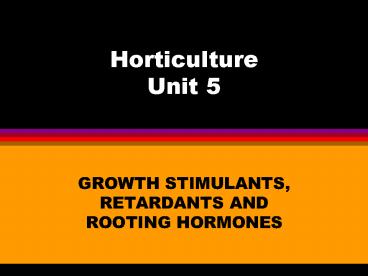Horticulture Unit 5 - PowerPoint PPT Presentation
1 / 13
Title:
Horticulture Unit 5
Description:
Horticulture Unit 5 GROWTH STIMULANTS, RETARDANTS AND ROOTING HORMONES Growth Regulating Substances Called hormones: organic chemicals which act and interact to ... – PowerPoint PPT presentation
Number of Views:138
Avg rating:3.0/5.0
Title: Horticulture Unit 5
1
HorticultureUnit 5
- GROWTH STIMULANTS, RETARDANTS AND ROOTING HORMONES
2
Growth Regulating Substances
- Called hormones organic chemicals which act and
interact to affect growth rate - Auxins accelerate growth by stimulating cell
enlargement - Gibberellins stimulate growth in stem and leaf
by cell elongation - Cytokinins stimulate cell division (only works
with auxins present) - Inhibitors inhibit seed germination, stem
elongation and hasten ripening of fruit.
3
Growth Hormones
- Organic chemicals principally produced by
actively growing plant tissue such as short tips
and young leaves. - They move throughout the plant and can be found
in many parts. - They react with one another.
4
Apical Dominance
- The terminal bud secrets chemicals which inhibit
or prevent growth of lateral buds. - This causes the plant to grow tall and not send
out side branches. - Seems to be a genetic program directing the plant
to grow above competing plants. - Once the plant reaches flowering age, the
terminal bud becomes a flower bud and the
chemicals are no longer secreted. - Pinching the terminal bud has the same effect and
side branching occurs sooner.
5
Major Discoveries
- Chemical and natural stimulants that cause plants
to grow taller or faster - Chemical retardants that cause plants to grow
slower - Hormones that cause plants to root faster
- Dwarfing rootstock for fruit trees
6
Chemical Stimulants
- Enables plants to grow taller.
- Most common is gibberellic acid
- Gibberellic acid causes the stems of plants to
stretch out - The nodes (the joints at which bulbs, leaves and
branches) are further apart
7
Natural Stimulants
- Chemical known as alcohol Triacontanol
- Found in alfalfa and has been known to nursery
men for 30 years. - Stimulation is brought about by mulching with
alfalfa hay or by watering plants with an alfalfa
tea
8
Chemical Retardants
- Used to retard the growth of plants making them
shorter and more compact and therefore more
attractive. - One of the newest applications for growth
retardants is on lawns, a chemical called Limit
is used new and it restricts grass growth for 6
to 8 weeks. - A new plant regulator called Sumagic reduces
the height of plants by inhibiting production of
the hormone Gibberellic acid. (which cause stems
to elongate)
9
Rooting Hormones
- When propagating plants from cuttings, it is very
important that they root as quickly as possible - Indoleacetic acid (IAA) is a natural plant
hormone that causes roots to form - Chemical hormones, indolebutyric acid (IBA) or
naphaleneacetic acid (NAA) are the most common
used today.
10
Rooting Hormones
- Rooting hormones are either mixed with talc and
used as powders or mixed with liquid and used as
a wet dip - All rooting hormones should contain a fungicide.
11
Dwarfing Rootstock
- As the cost of labor has increased, growers are
looking for smaller trees. - Discovered trees from certain types of roots, do
not grow as large and bear fruit earlier. - A complete series of rootstock known as malling
rootstock was developed.
12
Commercially Used Plant Growth Regulators
13
Student Activities
- Complete self-evaluation at the end of this unit.
- Using nursery catalogs and books, make a list of
available dwarf fruit trees and details.































